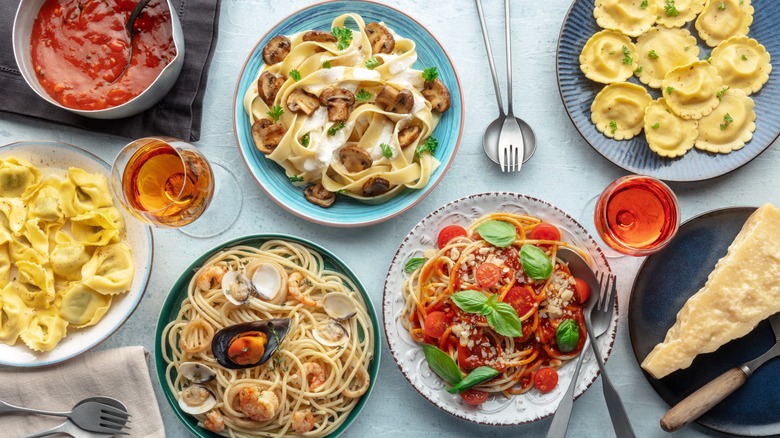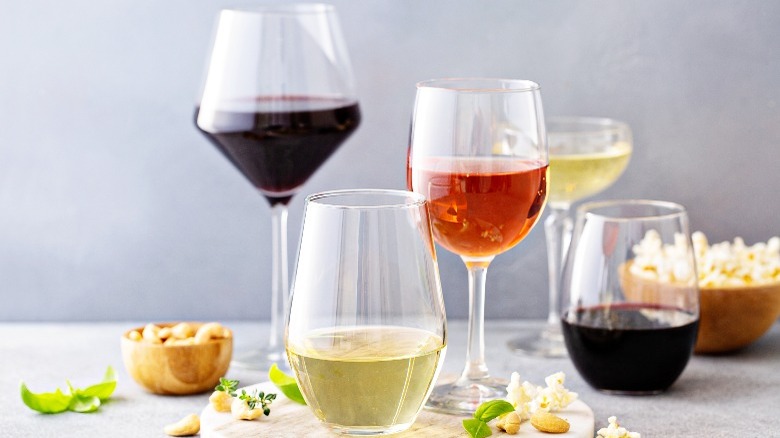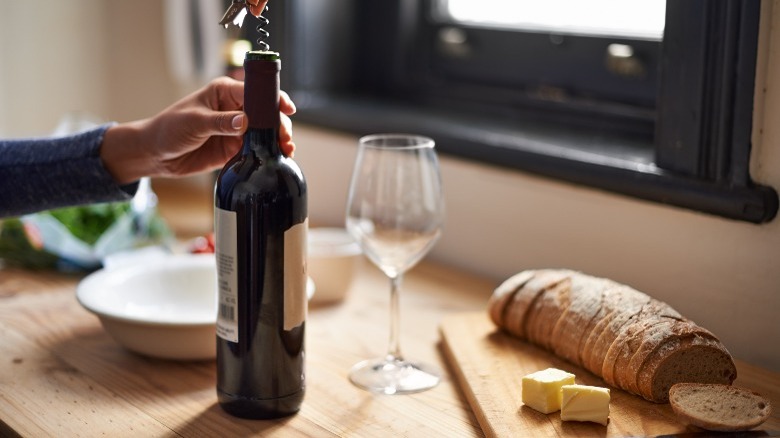The Common Mistake People Make When Adding Wine To Pasta Sauce
Chefs have been cooking with wine for centuries, even adding it to pasta sauces for vino's ability to elevate the meal. Preparing dishes with the liquid adds another layer of complex flavor. Additionally, a wine's tannins can bind to organic molecules to help to reduce some of the fattiness of a sauce, allowing the other ingredients to shine through. But, when using alcohol, there is an important step that people often forget.
A common mistake that's made when adding wine to pasta sauce is not letting it simmer for long enough before incorporating the other components. Uncooked, the raw bite of wine's flavors will still come through in the sauce. A good rule of thumb is to wait until about half of the wine evaporates, but the amount of time can depend on the type and amount you're using.
Red wines, for example, should be given ample space to reduce so that their flavors can fully develop. On the other hand, white wines don't typically take as long. You'll know it has heated sufficiently when the liquid in the pan starts to thicken slightly — taste it as it cooks to test how much alcohol flavor still comes through.
You won't actually cook off all of the alcohol or the flavor it can provide — to do so could take around three hours. In reality, when cooking with wine, only about 40% of its alcohol content will have evaporated after 15 minutes.
Red and white wines have different uses in sauces
While both red and white wines work well in pasta, each one will complement different dishes. In terms of white wine, a cheesy fettuccine alfredo could benefit from the addition, as the light fruitiness of the alcohol perfectly accents the cream. White varietals also pair well with poultry and seafood — think chicken and spaghetti tossed in buttery and garlic-y sauces, accented by white wine or even black pasta with mussels. Crisp dry wines like Pinot Grigio or Pinot Blanc are versatile and safe choices, but aromatic wines like Muscato provide more complexity in flavor.
Red wines typically go well with red sauces and beef — think marinara or bolognese. Celebrity chef Ina Garten's favorite wine to use when making bolognese is the dry and highly acidic Chianti because of its uniquely Italian flavor palette. Pinot Noirs match up deliciously well with pasta that features hard cheeses like parmesan or pecorino.
The most ideal red wines to cook with are those that don't have too many tannins — the molecules released when grape skins and stems are soaked in juice. Tannins become more concentrated as the wine is cooked, so if you start out with too many, your resulting sauce can become too dry. Additionally, they have a bitter and harsh taste, producing a dry mouth feeling you probably want to avoid in pasta sauce.
Tips for choosing wine for cooking
If you want to cook with wine, the general rule is to pick one you wouldn't mind drinking — but there's no need to use the most expensive stuff on the shelf. Pricey bottles are best savored alone as any special qualities are muddled when the wine cooks and combines with other ingredients. Just stay away from anything considered a "cooking wine," which has preservatives and sodium added to give it a longer shelf-life. The reason you wouldn't want to use cooking wines is twofold: You definitely wouldn't drink them as the high sodium gives them a bad taste, which can also add too much saltiness or even a metallic flavor to your sauce.
When choosing a white wine to cook with, it's likely best to use still over sparkling options. The lack of bubbles in a still wine make it easier to measure accurately. However, sparkling wines tend to be more acidic and therefore could add more of a flavor boost to the dish. If you happen to have accidentally let a bottle of bubbly go flat, take advantage of that extra acidity and incorporate it into your pasta sauce.
Besides watching out for tannins in red wines, you'll want to choose a bottle with minimal oak. Red wines are often aged in oak barrels, but like tannins, the wood's flavors can leave your sauce tasting off. Luckily, both tannins and oaky notes are more commonly found in the higher-end wines you shouldn't be opting to cook with anyway.



